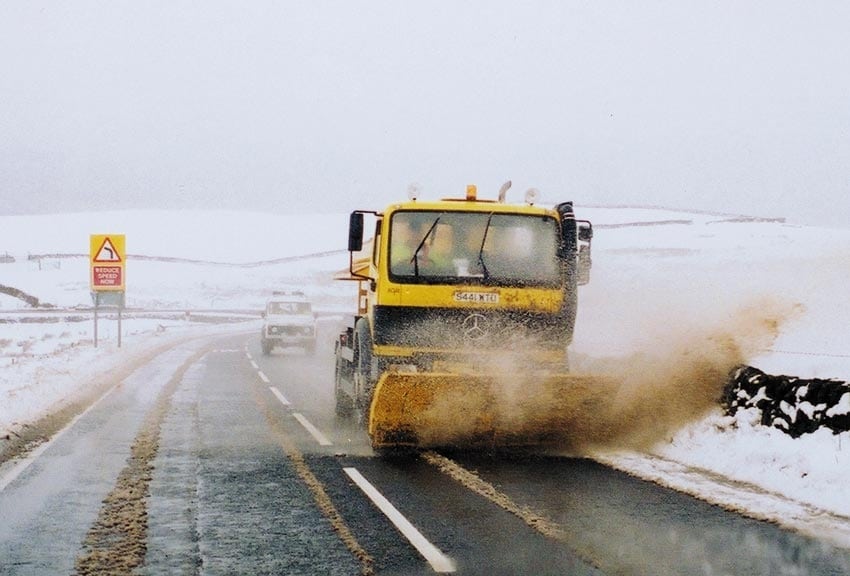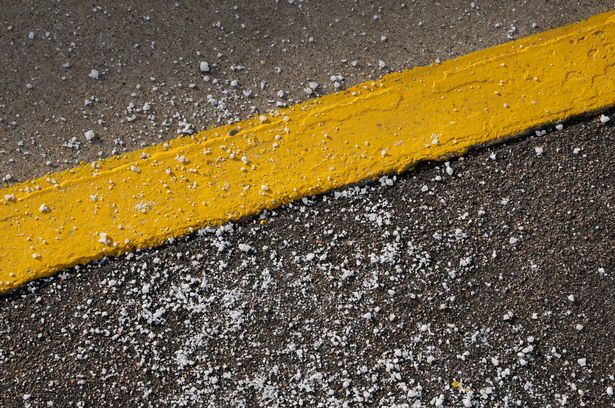If you’re a dog owner living in London, you’ve probably encountered rock salt grit during the winter months. Council gritters spread rock salt on the roads to stop black ice from forming and making roads slippery and dangerous; a lot of this salt can reach common pathways that dog walkers may take.
In this article, we will explain what dangers rock salt and grit pose for dogs and the best practices to ensure it doesn’t lead to any discomfort.
So, what exactly is rock salt grit, and how does it affect dogs?
Rock salt grit is a mixture of tiny rock salt crystals and grit, usually made from crushed rocks or gravel. It’s spread on surfaces to melt ice and snow, making walking or driving safer.
Unfortunately, when dogs walk on surfaces covered with rock salt grit, they can get stuck in their paws, causing irritation and even burns. Moreover, if your dog licks their paws, it can ingest the salt and grit, which can be extremely dangerous.
Rock salt grit is unsafe for dogs. Ingestion can lead to dehydration, vomiting, diarrhoea, and in severe cases, even kidney damage. It can also irritate the mouth, nose and eyes, making your furry friend uncomfortable.
What is rock salt grit, and how is it made?
Rock salt that gritters use doesn’t come from the sea but from underground mines. It is brownish with a texture similar to gravel. Rock salt is now used on the roads because the three primary rock salt mines in the UK are now more efficient, and they can lower the freezing point of water or de-ice existing water as it dissolves.
It’s a mixture of sodium, calcium, and magnesium chloride. These chemicals are all salt-based and work together to break down the ice and snow, making it easier to clear away.
In addition to its de-icing properties, rock salt grit is also used in agriculture and food production. It’s sometimes used as a mineral supplement for livestock, providing essential minerals that can be lacking in their diet.
Interestingly, it’s also used in cheese production, as it helps to promote the growth of bacteria that gives the cheese its flavour.
How does rock salt grit affect dogs?
Winter weather can be harsh and unforgiving, and many of us turn to rock salt grit to keep our driveways and pavements clear of ice and snow. However, it’s important to remember that our furry friends are also affected by the salt we use.
Rock salt is sodium chloride, a harsh chemical that’s a known skin irritant. Imagine walking barefoot for some time on a known skin irritant! This is a reality that dogs face every winter when the gritters spray their de-icing gravel, and it’s not an enjoyable experience for them.

1. Potential Hazards
Rock salt grit can be dangerous to dogs in two significant ways: physical and internal (gastrointestinal).
- It can irritate their paws, which can be painful and uncomfortable. As a result, your dog might start limping, licking their paws excessively, or showing signs of discomfort when walking.
- The high NaCl (sodium chloride) levels can lead to dehydration, vomiting, and diarrhoea if a dog ingests rock salt grit. In severe cases, it can even be fatal.
2. Short-term Effects
These can include irritation, soreness, and dryness of the skin on their paws. It can be particularly problematic for dogs with sensitive skin, as it can lead to open sores and infections.
Dogs may also experience discomfort and pain when walking on gritted pavements, leading to limping and a reluctance to exercise.
3. Long-term Effects
Prolonged exposure to rock salt can make your dog’s paws dry, cracked and even burns to the pads in severe cases.
Additionally, it can lead to chronic dehydration, kidney damage and other health problems. Dogs that regularly ingest rock salt grit may also be at risk of developing high blood pressure, which can increase the likelihood of heart disease.
It’s important to note that the effects of rock salt grit on dogs can vary depending on the breed, age, and overall health of the dog. Some dogs may be more sensitive to salt than others and experience more severe symptoms.
4. Rock Salt Poisoning
In addition to NaCl, rock salt can contain mercury, lead, and ferrocyanide.
According to RSPCA.ORG.UK, prolonged ingestion of salt grit can lead to rock salt poisoning among dogs which could be fatal or lead to permanent organ damage in the kidney and liver.
Symptoms of rock salt poison include drooling, vomiting, diarrhoea and a lack of appetite. It is not a pleasant experience to go through for both you and your furry friend.
In severe cases, ingesting too many harsh chemicals can lead to seizures, coma and death. The effects of rock salt poisoning are much more powerful than their impact on paws, but often the problem starts with the paws.
Read More: Best Dog Coats to Buy for Winter 2023 in the UK
How to protect your dogs from rock salt grit?
With all the negativity surrounding rock salt, keeping your dog indoors for 3 months would be best! But I wouldn’t recommend that at all.
Dogs still need regular exercise and, with regular walks, can avoid becoming frustrated and naughty. The solution is to reduce the dangers by limiting exposure to rock salt grit.
Avoid walking your dog on surfaces covered in rock salt grit. If you must take your dog out in icy conditions, consider using dog boots or paw wax to protect its paws. After a walk, clean your dog’s paws thoroughly to remove any grit and salt.
1. Avoid walking directly over apparent grit.
When you know there has been a grit-spreading session, avoid walking over the obvious brown piles of it.
Prominent areas of grit spreading are council-owned properties, school crossings and busy crossroads. You can’t avoid some grit on a walk, but you can go a long way in reducing your dog’s exposure.

2. Try a new walking area.
Local parks with fewer roads and concrete will have less grit. Taking a more adventurous trail may help you and your dog avoid the salty stuff. If there’s an opportunity to exercise them and allow them to relieve themselves indoors, that’s an option too.
3. Use dog booties.
A few brands and styles can completely cut the dog’s exposure to rock salt. The biggest downside is that not all dogs can take to these boots, and others will need time to adjust.
Read More: Which dog boots are the best and safest in 2023?
4. Wash your dog’s feet after the walk.
One of the most important things you can do after a winter walk is to wash your dog’s feet to stop their paws from getting chemical burns and to make sure your dog doesn’t like them after and get rock salt poisoning.
To wash them, put a cloth under warm water and gently dab and wipe their paws, paying extra attention to the crevices of the paw so that none are left behind. Alternatively, dip their paws into a bowl of warm water before drying them with a towel.
5. Behavioural training for dogs.
Training your dog to avoid licking or eating rock salt grit is another crucial step in protecting them. This can be achieved by using positive reinforcement to teach your dog the “leave it” command.
By consistently practising this command, your dog will learn to avoid rock salt, grit and other potentially harmful substances they may encounter on their walks.
Read More: Best Dog Walking Gloves You Can Buy in the UK 2023
What should I do if my dog comes into contact with rock salt grit?
If your dog comes into contact with rock salt grit, wash their paws with warm water and dry them thoroughly. You can also use a paw balm or protective booties to prevent further irritation. If your dog has ingested rock salt grit or is showing symptoms of salt poisoning, you should contact your veterinarian immediately.



